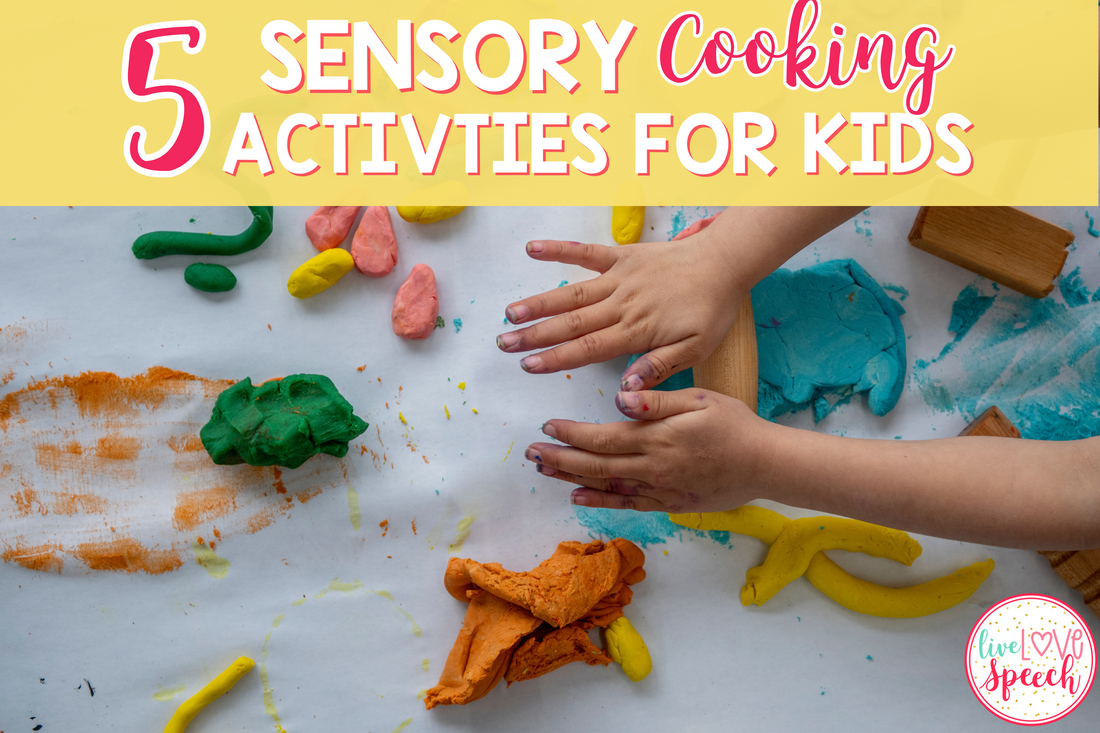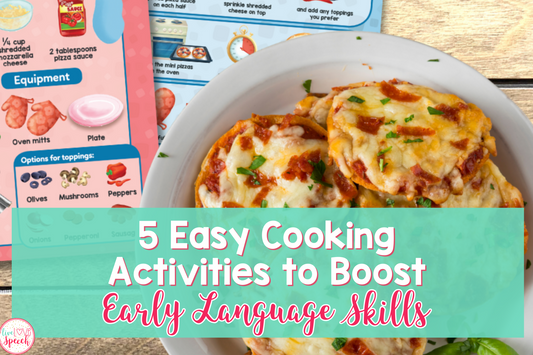
Who says learning can’t get a little messy? As an SLP, I know firsthand that kids will always choose sensory play over worksheets! Sensory experiences are essential for child development, helping kids build fine motor skills, explore new textures, and develop language skills. And what better way to dive in than through sensory cooking activities?
Stirring, squishing, and tasting not only make learning more engaging but create memorable, hands-on experiences that really stick!
Importance of Sensory Cooking Activities
Sensory play is such an essential part of how kids learn and grow. Over the past decade, I’ve seen this firsthand, watching kids light up when they get to do hands-on activities.
I remember shifting from sit-down tasks to sensory cooking projects, and the difference was immediate, kids were excited, laughing, and eager to participate! Whether mixing or measuring, they were fully engaged in ways that just don’t happen with worksheets. We were building language skills, expanding vocabulary, and strengthening fine motor abilities as we scooped, poured, and stirred together.
With sensory cooking, it’s not just about keeping little hands busy; it’s about laying the foundation for language and cognitive growth. These activities offer kids a rich sensory experience that supports language development, fine motor skills, and even social connections.
In this post, I’ll share five of my favorite sensory cooking activities that encourage children to explore textures, build language, and develop coordination in a fun, meaningful way.
Sensory Cooking Activities for Kids
1. Rainbow Spaghetti Play

Create a colorful sensory experience with dyed spaghetti! This fun activity lets kids explore different colors and textures with their hands, making it both exciting and great for language development.
Materials Needed: Cooked spaghetti, food coloring, plastic bags or bowls.
Steps:
- Cook and drain the spaghetti, then let it cool.
- Divide the spaghetti into bowls.
- Add a few drops of different food colorings to each bowl, then mix until the color is absorbed (use plastic bags for easy mixing if preferred).
- Spread out the colorful spaghetti and let the kids explore!
Speech and Language Focus: Encourage kids to describe the colors and textures they see and feel. Use words like “slippery,” “wiggly,” and “stretchy,” and talk about actions like “pulling” and “squishing.” This helps them learn new words in a fun, hands-on way!
2. Textured Playdough Creation:

This homemade textured playdough lets kids explore different sensory experiences by adding unique materials like rice, sand, or glitter. It’s a simple, hands-on way to add texture to their play!
Materials Needed: Flour, salt, water, oil, cream of tartar, and optional texture add-ins (like rice, sand, or glitter).
Steps:
Mix the basic playdough ingredients (flour, salt, water, oil, and cream of tartar).
- Add in your chosen textures, such as rice for a bumpy feel, sand for a grainy texture, or glitter for a sparkly touch.
- Let kids knead, roll, and shape the playdough, enjoying the different textures with each material.
Speech and Language Focus: This activity is perfect for practicing descriptive language! Encourage words like “bumpy,” “grainy,” “soft,” and “smooth” as kids describe what they feel. They can also practice following multi-step instructions as they work through each part of the activity.
These scented herb jars are a great way for kids to explore different smells while learning about herbs and spices. Each jar offers a unique sensory experience, perfect for hands-on learning and vocabulary building!
Materials Needed: Small mason jars, herbs, and spices like basil, mint, rosemary, cinnamon sticks, etc.
Steps:
- Fill each mason jar with a different herb or spice.
- Let children open the jars, smell the contents, and talk about what they notice.
Speech and Language Focus: This activity is ideal for expanding olfactory vocabulary! Encourage words like “minty,” “earthy,” “spicy,” and “fresh,” and ask kids to describe each scent and how it makes them feel. They’ll learn new words and practice expressing their reactions in a fun, sensory way.
4. Crunchy and Smooth Texture Exploration

This activity allows kids to explore and compare different food textures, from crunchy crackers to smooth yogurt. It’s a fun way for children to engage their senses while learning new descriptive words!
Materials Needed: Crackers, rice cakes, bananas, yogurt, small bowls.
Steps:
- Arrange the crunchy and smooth foods on plates or in small bowls.
- Have children touch, taste, and explore each food’s texture.
- Encourage kids to talk about how each texture feels and tastes, comparing the differences.
Speech and Language Focus: This activity helps kids practice comparative language like “crunchy vs. smooth” and descriptive words such as “crispy,” “soft,” or “squishy.” It’s a great way to boost their vocabulary while engaging in a fun sensory experience!
5. Ice Cream in a Bag
Kids will love making their own ice cream while shaking and feeling the cold! This fun and simple recipe focuses on hands-on sensory play and is perfect for a tasty treat they made themselves.
Materials Needed: Ziplock bags, milk, sugar, vanilla extract, ice, salt.
Steps:
- Mix the milk, sugar, and vanilla extract in a small Ziplock bag.
- Place the small bag inside a larger bag filled with ice and salt.
- Shake the bags for a few minutes until the mixture turns into ice cream.
- Let the kids enjoy their homemade ice cream while discussing what happened during the process.
Speech and Language Focus: Focus on action words like “shake,” “freeze,” and “pour.” Kids can describe the sensory experience of the cold ice and the movement of shaking, helping to build their vocabulary and language skills.
Tip: For an easy, kid-friendly guide to this recipe, you can use my Ice Cream in a Bag Visual Recipe from my June Visual Recipes! It’s a great way to help kids follow along step-by-step while enjoying the process.
When to Introduce These Activities?
These sensory cooking activities are perfect for a variety of settings! Whether you're at home with your child or in the classroom with a group of students. You can introduce these activities based on the age and developmental stage of the children:
-
Younger children (Ages 2-4): These activities are great for younger kids who are still developing fine motor skills and sensory processing. Activities like Rainbow Spaghetti Play or Scented Herb Sensory Jars can be introduced to help them explore textures, smells, and basic language.
-
Older children (Ages 5-7): As kids start building their vocabulary and following more complex instructions, you can introduce activities like Crunchy and Smooth Texture Exploration or Ice Cream in a Bag. These activities can also foster their independence as they engage in following simple recipes and working with sensory materials.
-
Children who need extra support: If a child needs extra help, you can modify these activities to meet their needs. For example, for children who may need help with motor skills or understanding multi-step instructions, simplify the activity or provide step-by-step visual aids. Visual recipes, like my Ice Cream in a Bag Visual Recipe, are perfect for guiding them through each step at their own pace. For more information on visual recipes check out my blog post Visual Recipe Cards.
And no matter the setting or age group, always keep safety in mind! For tips on keeping activities safe and manageable for everyone, check out my blog post on Cooking Safety Tips!
Ready to Get Cooking?
For more ideas and tips, be sure to check out my other blog posts and resources. Happy cooking and learning!
Don’t forget to pin this post for easy access to these fun and educational sensory cooking activities anytime you need them!







